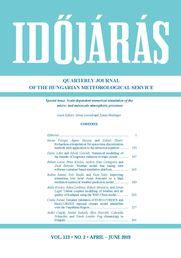IDŐJÁRÁS - angol nyelvű folyóirat
Vol. 123, No. 2 * Pages 135–264 * April - June 2019
 |
Special issue: Scale-dependent numerical simulation of the micro- and mesoscale atmospheric processes |
 letöltés [pdf: 8407 KB]
letöltés [pdf: 8407 KB]
Richardson extrapolation for space-time discretization methods with application to the advection equation
István Faragó, Ágnes Havasi, and Zahari Zlatev
DOI:10.28974/idojaras.2019.2.1 (p. 135–)
István Faragó, Ágnes Havasi, and Zahari Zlatev
DOI:10.28974/idojaras.2019.2.1 (p. 135–)
Numerical modeling of the transfer of longwave radiation in water clouds
Eszter Lábó and István Geresdi
DOI:10.28974/idojaras.2019.2.2 (p. 147–)
Eszter Lábó and István Geresdi
DOI:10.28974/idojaras.2019.2.2 (p. 147–)
Weather model fine-tuning with software container-based simulation platform
Róbert Lovas, Péter Kardos, András Zénó Gyöngyösi, and Zsolt Bottyán
DOI:10.28974/idojaras.2019.2.3 (p. 165–)
Róbert Lovas, Péter Kardos, András Zénó Gyöngyösi, and Zsolt Bottyán
DOI:10.28974/idojaras.2019.2.3 (p. 165–)
Improving wintertime low level cloud forecasts in a high resolution numerical weather prediction model
Balázs Szintai, Eric Bazile, and Yann Seity
DOI:10.28974/idojaras.2019.2.4 (p. 183–)
Balázs Szintai, Eric Bazile, and Yann Seity
DOI:10.28974/idojaras.2019.2.4 (p. 183–)
Online coupled modeling of weather and air quality of Budapest using the WRF-Chem model
Attila Kovács, Ádám Leelőssy, Róbert Mészáros, and István Lagzi
DOI:10.28974/idojaras.2019.2.5 (p. 203–)
Attila Kovács, Ádám Leelőssy, Róbert Mészáros, and István Lagzi
DOI:10.28974/idojaras.2019.2.5 (p. 203–)
Detailed validation of EURO-CORDEX and Med-CORDEX regional climate model ensembles over the Carpathian Region
Csaba Zsolt Torma
DOI:10.28974/idojaras.2019.2.6 (p. 217–)
Csaba Zsolt Torma
DOI:10.28974/idojaras.2019.2.6 (p. 217–)
Fog climatology in Hungary
Anikó Cséplő, Noémi Sarkadi, Ákos Horváth, Gabriella Schmeller, and Tünde Lemler
DOI:10.28974/idojaras.2019.2.7 (p. 241–)
Anikó Cséplő, Noémi Sarkadi, Ákos Horváth, Gabriella Schmeller, and Tünde Lemler
DOI:10.28974/idojaras.2019.2.7 (p. 241–)
IDŐJÁRÁS folyóirat

Az IDŐJÁRÁS a HungaroMet Nonprofit Zrt. negyedévenként megjelenő angol nyelvű folyóirata
Megrendelhető a journal.idojaras@met.hu címen.
A szerzőknek szánt útmutató itt olvasható.
Megrendelhető a journal.idojaras@met.hu címen.
A szerzőknek szánt útmutató itt olvasható.









